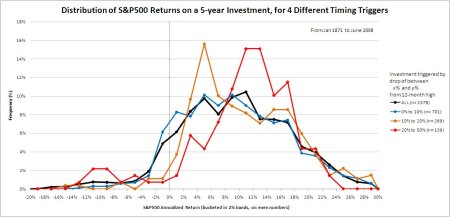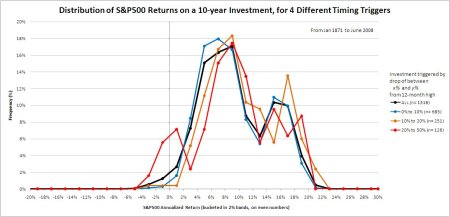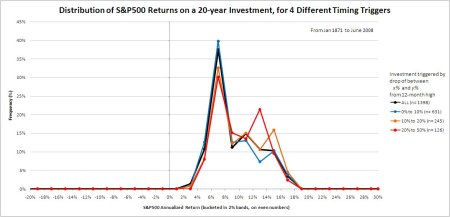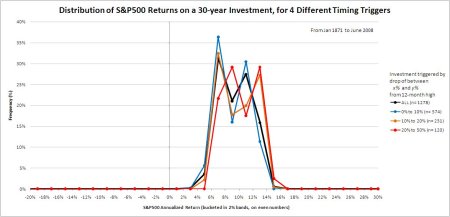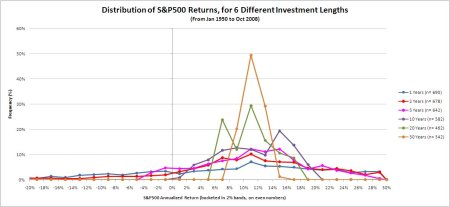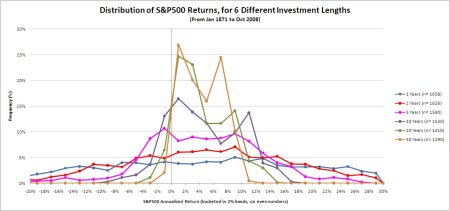In this post I will look at whether times like these (when the market has fallen a lot) are good times to invest.
With the recent fall in market values, there are folks suggesting that right now is a good time to invest. There is equally a lot of fear among investors. Warren buffet summed it up well in his article. I want to know whether history suggests that there is anything to be gained from trying to time the market by buying after a fall.
I felt, as usual, that there is no substitute for getting my hands dirty in the data, so I did a little analysis. I tested how the distribution of returns on a S&P 500 investment made in months that follow a fall in the value of the index compare to investment made at any point in time – i.e. can the market be timed?
I have calculated the distribution of annualized returns for an investment in the S&P 500 made under four different scenarios:
- Any month (baseline)
- Any month where the current index value is 0%-10% down on the 12-month high
- Any month where the current index value is 10%-20% down on the 12-month high
- Any month where the current index value is 20%-50% down on the 12-month high
Note: this is not a 20/20-hindsight analysis. I have not looked back at the data and picked the ‘bottom of the market’ as the investing point. I have used only the data that one would have had available at the point that one made the investment.
Here’s what it looks like for a 5-year investment:
Your looking at four lines. The black one is the distribution of returns for an investment made at any point in time, the blue for investments made in months where the index value is down 0%-10% on the 12-month high, orange 10%-20% down, red 20%-50% down. Here what I see:
- When the market is down 0% to 10%, its not worth trying to time a 5-year investment
- When the market is down 20% to 50%, a 5-year investment will get better returns than one invested at a random point in time, on average.
- When the market is down 20% to 50%, it is still possible (but not probable) to lose a lot of money on a 5-year investment. Look at the red bump at -10% – it is from the Great Depression!
What do you see? Are we looking at signal or noise?
I picked a 5-year investment to look at first because my last post suggested that 5 years isn’t really long enough to be confident of returns that out-perform some safer investment options.
Now let’s look at the 10, 20 and 30 year versions of this chart:
Looking at these three charts, I see two things:
- For 10-year investments, investing when the market is down 20% to 50% is probably going to produce better returns than a investment at a random point in time, but it’s a close call
- For 20-year and 30-year investment there is no significant advantage to investing when the market is down, even by 20% to 50%
What do you see?
So my conclusion *would* be that you can time the market for medium term investments (5-year and 10-year) but not for long term investments (20-year, 30-year). I say ‘would’ because I must caveat all this with the facts that: I’m nothing more than a dabbler at this; I’m probably missing something; if it were this straight forward then why hasn’t the market already self-adjusted for this fact? Then again, Buffett says buy now for the long term, but who amongst us actually is?
If I were to translate this into advice (which this is categorically not, since I am not an advisor) then it would be:
- If you’re looking to make a 20 or 30 year investment then JFDI, irrespective of the market conditions
- If you’re looking to make a 5 to 10 year investment and you really need the money at the end of that period (i.e. retirement) then be cautious of the S&P 500 overall (at any point in time) and be a little more bullish if you’re investing at a time when the index has seen a 20% to 50% fall in value
WARNING: Details
In this final section I shall deal with the methodology details , and show some charts for comparison to my previous post.
Overall there are three changes in methodology from my previous post, which I want to highlight and compare, so that you can see why these results are different from that post:
- The reinvestment of dividends to measure total return
- A different data source (now Shiller, previously Yahoo Finance)
- A different time range (now Jan 1871 – Jun 2008, previously Jan 1950 to Oct 2008)
1. Dividends
I calculated total return by reinvesting dividends on a monthly basis, as follows:
- The dividend in month n is used to buy more units of the assett at the month-n price
- The dividend in month n+1 is paid out on the number of units in month-n including the addition of the units bought with the dividend in month-n
- The dividend reinvestment happens monthly, using 1/12 of the annual dividend (the data set has a lot of interpolation in it anyhow)
- No income tax is paid on the dividend, which would be true of a 401(k) or IRA, but generally not otherwise
The chart below show how the chart from the previous post would have looked with the reinvestment of dividends as detailed above:
2. Different Data Source
I used data provided by Robert Shiller, to whom I’m grateful – you can read about it here. The data has a monthly price and monthly dividend for the ‘S&P 500’ (proxy) from 1871 to June 2008.
I compared the two data sources to each other by repeating the analysis from my previous post on the new data source. The results were only different in very very minor ways, so we can rest easy..
3. Different Time Range (now Jan 1871 – Jun 2008, previously Jan 1950 to Oct 2008)
The new data source adds data from the years 1871-1941, which is good not only because it increases sample size, but because it includes the Great Depression, to which current times are being compared. The results with these new years look different, but essential tell the same story as the last post – i.e. that a ‘long’ investment probably should 20 or 30 years. The charts below show the results from my previous post redone with dividend reinvestment and with the full range of data 1871-2008:
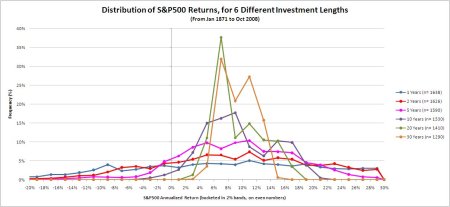
Results from my previous post redone with dividend reinvestment and the full range of data from 1871
And for completeness, the chart below shows the results from my previous post redone without dividend reinvestment, but for the full range of data from 1871 to 2008. Note that the returns look pretty dismal here, and there a good reason: In the years 1871 to 1950 the dividend yields were high (5%+), so by not including it in the calculation of the return, the majority of the return is missing.
